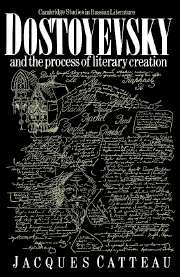Book contents
- Frontmatter
- Contents
- Preface to the English edition
- List of abbreviations
- General editor's note on transliteration and references
- General introduction
- PART I The creative environment
- PART II The process of creation
- Introduction
- 7 The writer at work
- 8 The great dialogue: the news item
- 9 The great dialogue: migrant images
- 10 The play of dialogue
- 11 The unity of thought in the novel
- 12 The summit of creative interrogation: ‘The Life of a Great Sinner’
- 13 A Raw Youth: reasons for choice
- 14 A Raw Youth: the appearance of the vision
- 15 A Raw Youth: the human architecture
- 16 A Raw Youth: the Idea of the novel
- 17 The composition of the novel in Dostoyevsky's work: choice of chronicle form
- 18 Composition of the novel in A Raw Youth: chronicle and stories
- Part III Time and space in the world of the novels
- Conclusion
- Notes
- Select bibliography
- Index of names
17 - The composition of the novel in Dostoyevsky's work: choice of chronicle form
Published online by Cambridge University Press: 18 December 2009
- Frontmatter
- Contents
- Preface to the English edition
- List of abbreviations
- General editor's note on transliteration and references
- General introduction
- PART I The creative environment
- PART II The process of creation
- Introduction
- 7 The writer at work
- 8 The great dialogue: the news item
- 9 The great dialogue: migrant images
- 10 The play of dialogue
- 11 The unity of thought in the novel
- 12 The summit of creative interrogation: ‘The Life of a Great Sinner’
- 13 A Raw Youth: reasons for choice
- 14 A Raw Youth: the appearance of the vision
- 15 A Raw Youth: the human architecture
- 16 A Raw Youth: the Idea of the novel
- 17 The composition of the novel in Dostoyevsky's work: choice of chronicle form
- 18 Composition of the novel in A Raw Youth: chronicle and stories
- Part III Time and space in the world of the novels
- Conclusion
- Notes
- Select bibliography
- Index of names
Summary
Reflect, reflect before writing. Everything depends on the conception. This axiom of the great Goethe is the simplest and most marvellous summary and precept for all possible works of art.
Gustave Flaubert, Letter to Louise Colet, 13 September 1852The musical comparison
For Dostoyevsky, to compose was to set the original chaos in order, forging the unity of the novel without betraying the dialectic totality. It was a formidable task. All the elements of the composition had to harmonise in a set of meanings which were perpetually overtaking each other. The novel of Dostoyevsky is essentially teleological, as we have seen from the difficult construction of the human architecture: the antagonistic spheres of the people gravitating around Versilov and the Youth finally dissolved into a vertical structure which signified both parenthood and break. The Idea of the novel, first separated from its placenta and then passionately tested by experience, is another example of the teleological nature of A Raw Youth: the monolithic theme of social, family, national and spiritual disorder was succeeded by the fertile dialectic of disorder and the desire for order; the pessimistic and static statement was replaced by the optimistic dynamics of struggle.
Before approaching A Raw Youth, we shall consider the problem of composition in Dostoyevsky's work as a whole. Like E. M. de Vogüé and Vyacheslav Ivanov, Leonid Grossman, followed on this point by Mikhail Bakhtin, who sees in this form of composition an eloquent confirmation of his thesis on polyphony, stressed the musical character of Dostoyevsky's works.
- Type
- Chapter
- Information
- Dostoyevsky and the Process of Literary Creation , pp. 296 - 314Publisher: Cambridge University PressPrint publication year: 1989



